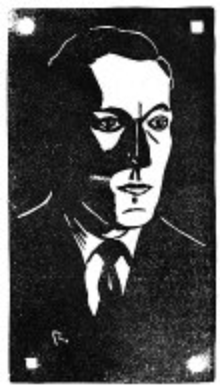Duane W. Rimel
Duane W. Rimel | |
|---|---|
| Born | February 21, 1915 Asotin, Washington, U.S. |
| Died | September 30, 1996 (aged 81) Bainbridge Island, Washington, U.S. |
| Pen name | Rex Weldon |
| Occupation | Writer |
| Genre |
|
| Notable works | "The Tree on the Hill" |
Duane Weldon Rimel (February 21, 1915 – September 30, 1996) was an American writer of speculative and erotic literature who is best known for his friendship with H. P. Lovecraft.
Life[]
Duane W. Rimel was born on February 21, 1915, in Asotin, Washington.[1]

H. P. Lovecraft began corresponding with Rimel after becoming aware of him in 1933. The resulting correspondence continued until Lovecraft's death in 1937. He introduced Rimel to F. Lee Baldwin, another author and resident of Asotin, Washington.[2] Lovecraft tutored Rimel in the writing of weird fiction by giving him advice and weird texts from his personal library. He sent Lovecraft some early manuscripts, including a now-lost work titles "The Spell of the Blue Stone" in February 1934. Lovecraft regarded this story as being "very remarkable for a beginner's work". Next, he sent "The Tree on the Hill", which Lovecraft edited. This story was later published in the 1940 issue of the fanzine Polaris. In the summer of that year, Rimel sent a poetic manuscript titled "The Dreams of Yid". Lovecraft altered the title to "The Dreams of Yith", as Rimel had not been aware that the term "yid" is an offensive term for a Jewish person. The sonnets were published in two issues of the Fantasy Fan.[3] Lovecraft, who was professionally revising stories for clients, did not charge Rimel for his revisions. Instead, he viewed Rimel as needing help in his formative period as a writer.[4]
In the April 1935 issue of Julius Schwartz's Fantasy Magazine, contained a biographical sketch of H. P. Lovecraft by F. Lee Baldwin. This article was one of the first fanzine biographies of Lovecraft, preceding those written shortly after his death. Rimel contributed a linocut portrait of Lovecraft that he had made to illustrate the biography.[5] In August 1937, Rimel discussed the idea of jointly founding a fanzine with Lovecraft and Emil Petaja titled the Fantaisiste's Mirror. Its goal would have been to complete the publication of Lovecraft's "Supernatural Horror in Literature" that was started in the defunct Fantasy Fan. This fanzine was never published.[6]
The authors' final collaboration was a work called "The Disinterment", which was written in the summer of 1935. According to Lovecraft, he made "slight verbal changes" to the manuscript that Rimel had provided. Rimel later maintained that he had mostly written the story himself.[7] However, S. T. Joshi, a Lovecraft scholar, has argued that the story was mostly written by Lovecraft, citing its stylistic similarities with "The Outsider" and Lovecraft's other early stories. Joshi also argues that Rimel never wrote anything as well-written or Lovecraftian again. After an initial rejection by Farnsworth Wright the story was accepted in July 1936. However, it was not published in Weird Tales until January 1937.[8]
After Lovecraft's death, Rimel primarily shifted to writing Westerns and erotic literature. These stories were published under pseudonyms, such as Rex Weldon. Using this pseudonym, he published Time Swap in 1969. This novel centers on time travel and sexuality.[9] He also involved himself with the early development of the Lovecraft fandom in the 1940s. During this time, Rimel introduced Francis T. Laney to the fandom. They cofounded The Acolyte, an early Lovecraftian fanzine, with F. Lee Balswin in 1942. This fanzine became one of the central outlets in the early fandom.[10] He died on September 30, 1996, in Bainbridge Island, Washington.[1]
Citations[]
- ^ a b The Encyclopedia of Science Fiction 2018.
- ^ Joshi 2010, p. 966.
- ^ Joshi 2010, pp. 989–991; Burleson 1983, pp. 3–4; Price 1982, pp. 1–3.
- ^ Joshi 2010, pp. 989–991.
- ^ Lovecraft 2007, pp. 38–39; Joshi 2010, p. 1056.
- ^ Joshi 2010, p. 1056; de Camp 1975, p. 392.
- ^ Murray 1988, pp. 31–33; Joshi 2010, pp. 1066–1067.
- ^ Joshi 2010, pp. 1066–1067.
- ^ Joshi 2010, p. 1139; The Encyclopedia of Science Fiction 2018.
- ^ Joshi 2010, p. 1139.
References[]
- Burleson, Donald R. (November 1, 1983). "Lovecraftian Branches in Rimel's 'Tree'". Crypt of Cthulhu. Vol. 3, no. 1. pp. 3–4. ISSN 1077-8179.
- de Camp, L. Sprague (1975). Lovecraft: A Biography (First ed.). Garden City, New York: Doubleday. ISBN 0-385-00578-4. OCLC 979196. S2CID 190754775.
- Joshi, S. T. (2010). I Am Providence: The Life and Times of H. P. Lovecraft (First ed.). New York: Hippocampus Press. ISBN 978-0-9824296-7-9. OCLC 650504348. S2CID 190428196.
- Lovecraft, H. P. (2007). Joshi, S. T.; Schultz, David E. (eds.). "Letters to Lee McBride White". Lovecraft Annual (1): 31–64. ISSN 1935-6102. JSTOR 26868354.
- Murray, Will (Fall 1988). "Facts in the Case of 'The Disinterment'". Lovecraft Studies. 7 (2): 30–33. ISSN 0899-8361.
- Price, Robert M. (December 17, 1982). "Introduction". Crypt of Cthulhu. Vol. 2, no. 2. pp. 1–3. ISSN 1077-8179. Archived from the original on July 29, 2014.
- "Rimel, Duane W". The Encyclopedia of Science Fiction. 2018.
External links[]
- 1915 births
- 1996 deaths
- 20th-century American male writers
- 20th-century American novelists
- 20th-century American poets
- 20th-century American short story writers
- American fantasy writers
- American horror writers
- American letter writers
- American magazine editors
- American male novelists
- American male poets
- American science fiction writers
- Cthulhu Mythos writers
- Pulp fiction writers
- Weird fiction writers